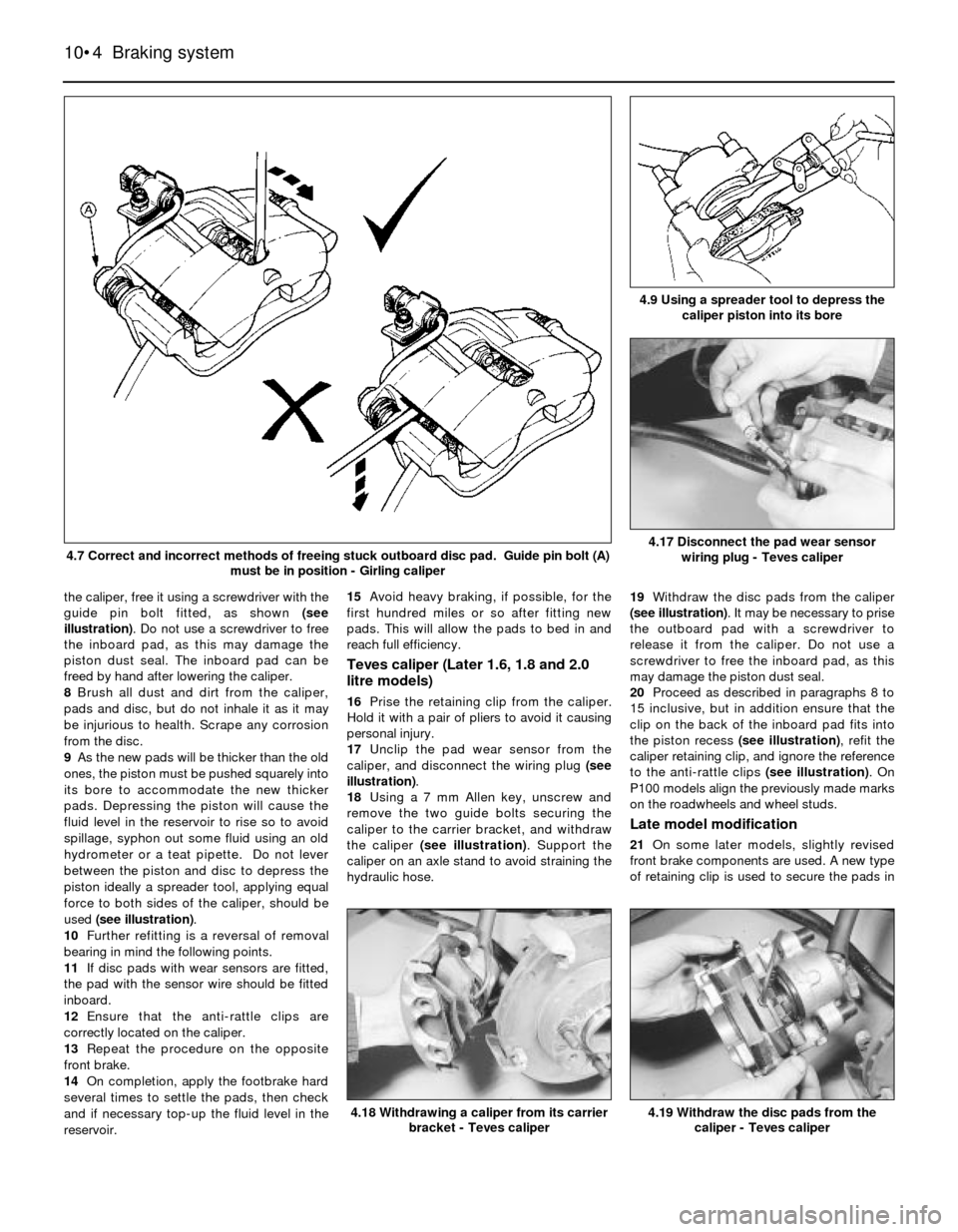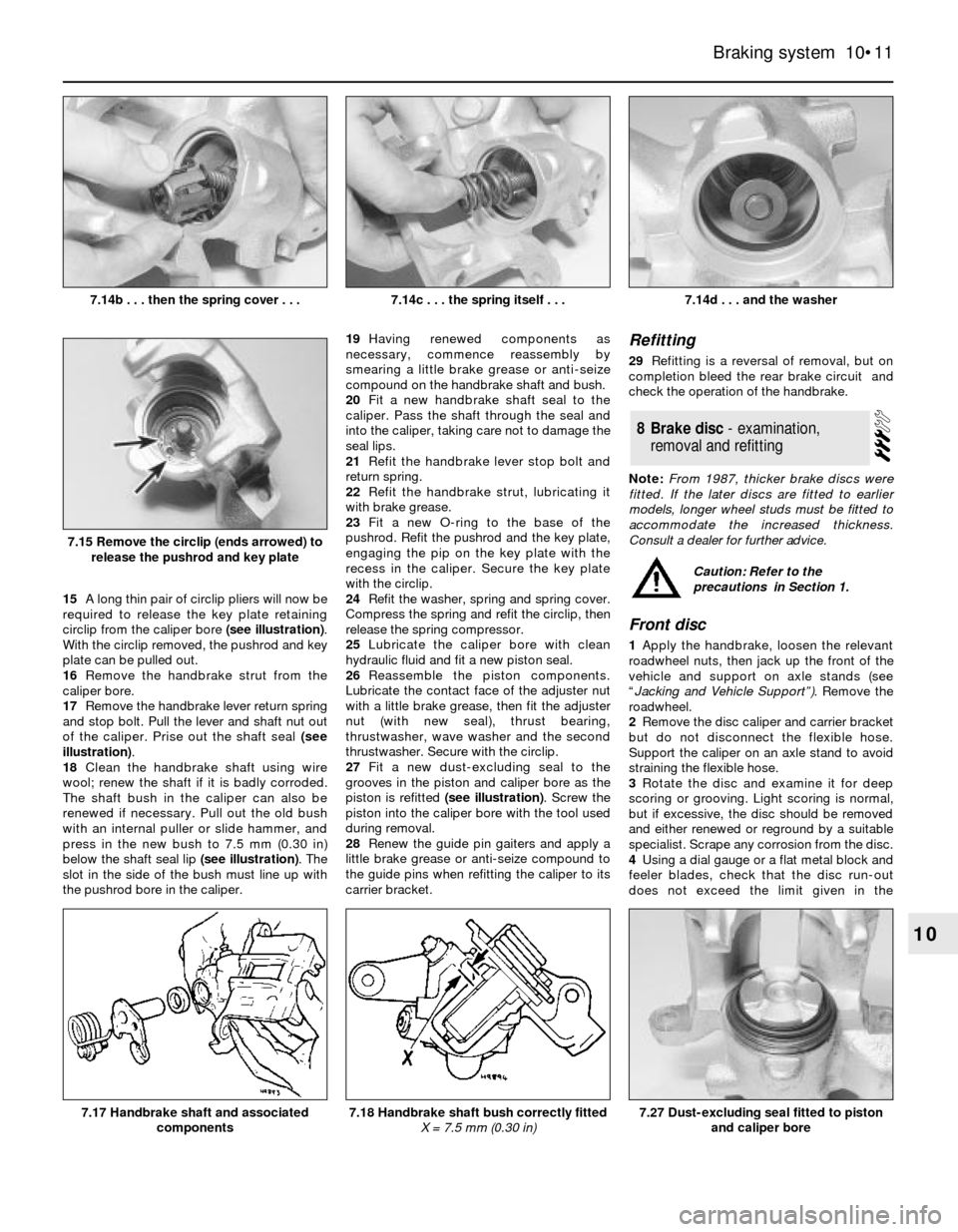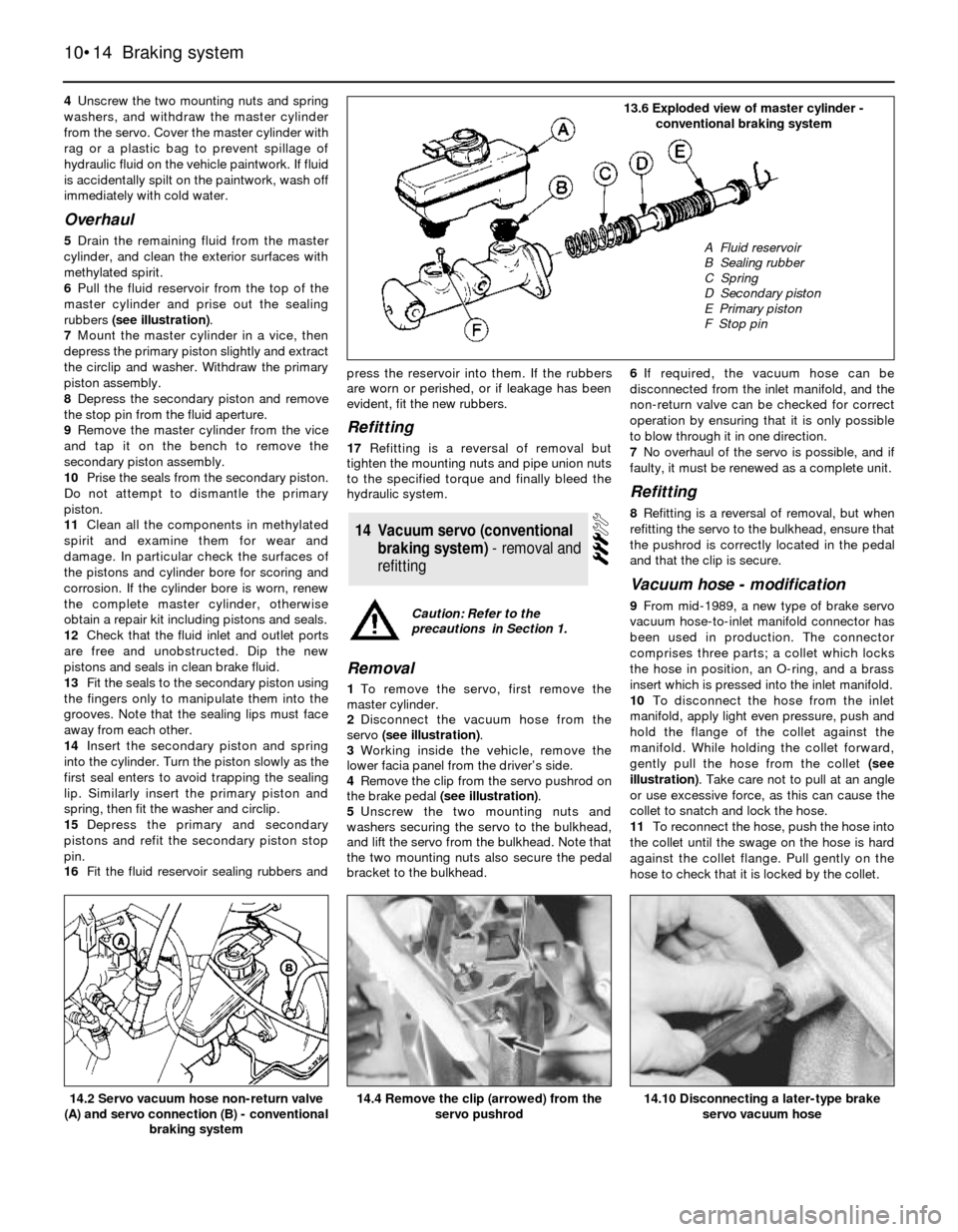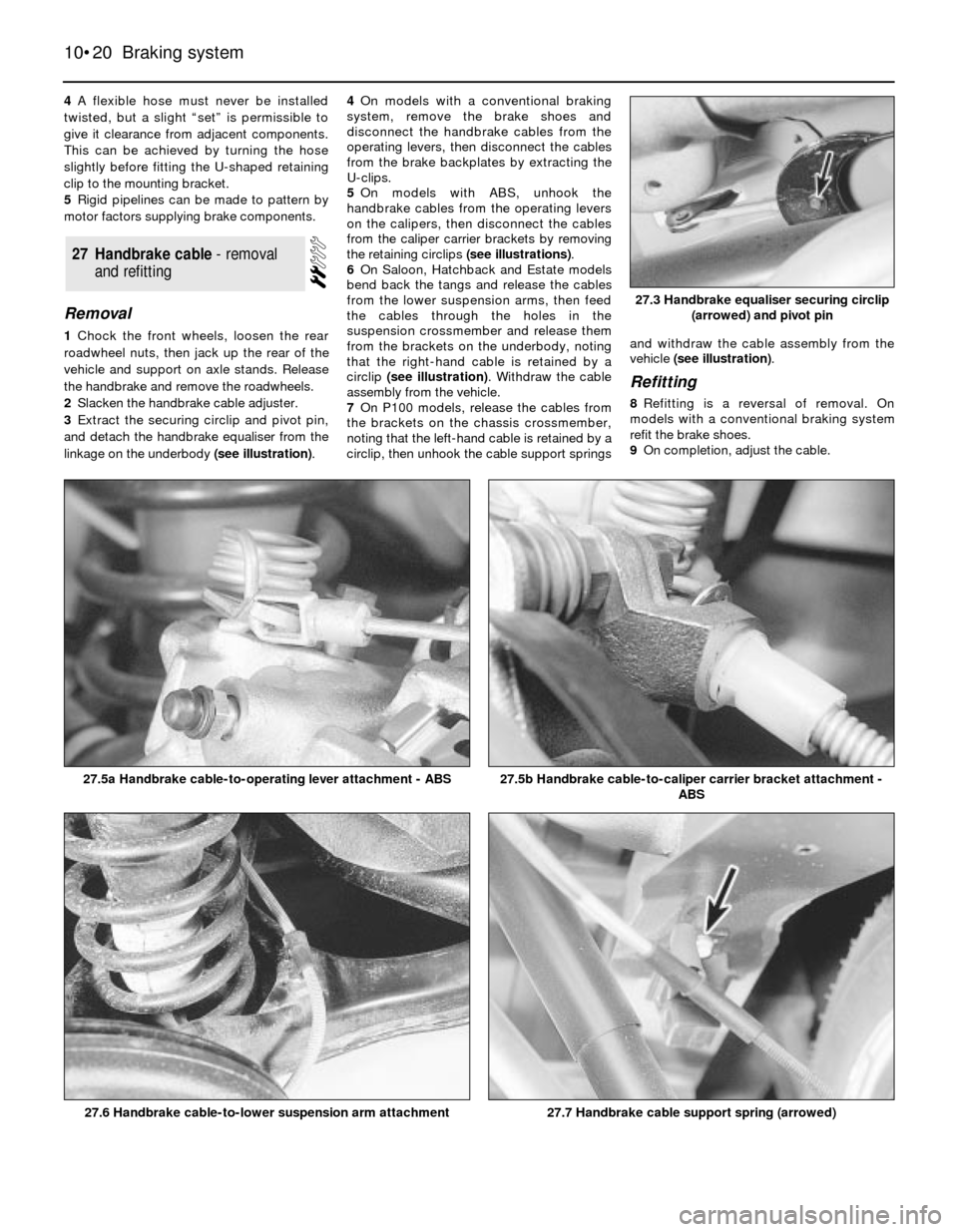light FORD SIERRA 1992 2.G Braking System Workshop Manual
[x] Cancel search | Manufacturer: FORD, Model Year: 1992, Model line: SIERRA, Model: FORD SIERRA 1992 2.GPages: 22, PDF Size: 1.11 MB
Page 4 of 22

the caliper, free it using a screwdriver with the
guide pin bolt fitted, as shown (see
illustration). Do not use a screwdriver to free
the inboard pad, as this may damage the
piston dust seal. The inboard pad can be
freed by hand after lowering the caliper.
8Brush all dust and dirt from the caliper,
pads and disc, but do not inhale it as it may
be injurious to health. Scrape any corrosion
from the disc.
9As the new pads will be thicker than the old
ones, the piston must be pushed squarely into
its bore to accommodate the new thicker
pads. Depressing the piston will cause the
fluid level in the reservoir to rise so to avoid
spillage, syphon out some fluid using an old
hydrometer or a teat pipette. Do not lever
between the piston and disc to depress the
piston ideally a spreader tool, applying equal
force to both sides of the caliper, should be
used (see illustration).
10Further refitting is a reversal of removal
bearing in mind the following points.
11If disc pads with wear sensors are fitted,
the pad with the sensor wire should be fitted
inboard.
12Ensure that the anti-rattle clips are
correctly located on the caliper.
13Repeat the procedure on the opposite
front brake.
14On completion, apply the footbrake hard
several times to settle the pads, then check
and if necessary top-up the fluid level in the
reservoir. 15Avoid heavy braking, if possible, for the
first hundred miles or so after fitting new
pads. This will allow the pads to bed in and
reach full efficiency.
Teves caliper (Later 1.6, 1.8 and 2.0
litre models)
16Prise the retaining clip from the caliper.
Hold it with a pair of pliers to avoid it causing
personal injury.
17Unclip the pad wear sensor from the
caliper, and disconnect the wiring plug (see
illustration).
18Using a 7 mm Allen key, unscrew and
remove the two guide bolts securing the
caliper to the carrier bracket, and withdraw
the caliper (see illustration). Support the
caliper on an axle stand to avoid straining the
hydraulic hose.19Withdraw the disc pads from the caliper
(see illustration). It may be necessary to prise
the outboard pad with a screwdriver to
release it from the caliper. Do not use a
screwdriver to free the inboard pad, as this
may damage the piston dust seal.
20Proceed as described in paragraphs 8 to
15 inclusive, but in addition ensure that the
clip on the back of the inboard pad fits into
the piston recess (see illustration), refit the
caliper retaining clip, and ignore the reference
to the anti-rattle clips (see illustration). On
P100 models align the previously made marks
on the roadwheels and wheel studs.
Late model modification
21On some later models, slightly revised
front brake components are used. A new type
of retaining clip is used to secure the pads in
10•4Braking system
4.7 Correct and incorrect methods of freeing stuck outboard disc pad. Guide pin bolt (A)
must be in position - Girling caliper
4.9 Using a spreader tool to depress the
caliper piston into its bore
4.19 Withdraw the disc pads from the
caliper - Teves caliper4.18 Withdrawing a caliper from its carrier
bracket - Teves caliper
4.17 Disconnect the pad wear sensor
wiring plug - Teves caliper
Page 11 of 22

15A long thin pair of circlip pliers will now be
required to release the key plate retaining
circlip from the caliper bore (see illustration).
With the circlip removed, the pushrod and key
plate can be pulled out.
16Remove the handbrake strut from the
caliper bore.
17Remove the handbrake lever return spring
and stop bolt. Pull the lever and shaft nut out
of the caliper. Prise out the shaft seal (see
illustration).
18Clean the handbrake shaft using wire
wool; renew the shaft if it is badly corroded.
The shaft bush in the caliper can also be
renewed if necessary. Pull out the old bush
with an internal puller or slide hammer, and
press in the new bush to 7.5 mm (0.30 in)
below the shaft seal lip (see illustration). The
slot in the side of the bush must line up with
the pushrod bore in the caliper.19Having renewed components as
necessary, commence reassembly by
smearing a little brake grease or anti-seize
compound on the handbrake shaft and bush.
20Fit a new handbrake shaft seal to the
caliper. Pass the shaft through the seal and
into the caliper, taking care not to damage the
seal lips.
21Refit the handbrake lever stop bolt and
return spring.
22Refit the handbrake strut, lubricating it
with brake grease.
23Fit a new O-ring to the base of the
pushrod. Refit the pushrod and the key plate,
engaging the pip on the key plate with the
recess in the caliper. Secure the key plate
with the circlip.
24Refit the washer, spring and spring cover.
Compress the spring and refit the circlip, then
release the spring compressor.
25Lubricate the caliper bore with clean
hydraulic fluid and fit a new piston seal.
26Reassemble the piston components.
Lubricate the contact face of the adjuster nut
with a little brake grease, then fit the adjuster
nut (with new seal), thrust bearing,
thrustwasher, wave washer and the second
thrustwasher. Secure with the circlip.
27Fit a new dust-excluding seal to the
grooves in the piston and caliper bore as the
piston is refitted (see illustration). Screw the
piston into the caliper bore with the tool used
during removal.
28Renew the guide pin gaiters and apply a
little brake grease or anti-seize compound to
the guide pins when refitting the caliper to its
carrier bracket.
Refitting
29Refitting is a reversal of removal, but on
completion bleed the rear brake circuit and
check the operation of the handbrake.
Note: From 1987, thicker brake discs were
fitted. If the later discs are fitted to earlier
models, longer wheel studs must be fitted to
accommodate the increased thickness.
Consult a dealer for further advice.
Front disc
1Apply the handbrake, loosen the relevant
roadwheel nuts, then jack up the front of the
vehicle and support on axle stands (see
“Jacking and Vehicle Support”). Remove the
roadwheel.
2Remove the disc caliper and carrier bracket
but do not disconnect the flexible hose.
Support the caliper on an axle stand to avoid
straining the flexible hose.
3Rotate the disc and examine it for deep
scoring or grooving. Light scoring is normal,
but if excessive, the disc should be removed
and either renewed or reground by a suitable
specialist. Scrape any corrosion from the disc.
4Using a dial gauge or a flat metal block and
feeler blades, check that the disc run-out
does not exceed the limit given in the
8Brake disc - examination,
removal and refitting
Braking system 10•11
10
7.14d . . . and the washer
7.27 Dust-excluding seal fitted to piston
and caliper bore7.18 Handbrake shaft bush correctly fitted
X = 7.5 mm (0.30 in)7.17 Handbrake shaft and associated
components
7.15 Remove the circlip (ends arrowed) to
release the pushrod and key plate
7.14c . . . the spring itself . . .7.14b . . . then the spring cover . . .
Caution: Refer to the
precautions in Section 1.
Page 14 of 22

4Unscrew the two mounting nuts and spring
washers, and withdraw the master cylinder
from the servo. Cover the master cylinder with
rag or a plastic bag to prevent spillage of
hydraulic fluid on the vehicle paintwork. If fluid
is accidentally spilt on the paintwork, wash off
immediately with cold water.
Overhaul
5Drain the remaining fluid from the master
cylinder, and clean the exterior surfaces with
methylated spirit.
6Pull the fluid reservoir from the top of the
master cylinder and prise out the sealing
rubbers (see illustration).
7Mount the master cylinder in a vice, then
depress the primary piston slightly and extract
the circlip and washer. Withdraw the primary
piston assembly.
8Depress the secondary piston and remove
the stop pin from the fluid aperture.
9Remove the master cylinder from the vice
and tap it on the bench to remove the
secondary piston assembly.
10Prise the seals from the secondary piston.
Do not attempt to dismantle the primary
piston.
11Clean all the components in methylated
spirit and examine them for wear and
damage. In particular check the surfaces of
the pistons and cylinder bore for scoring and
corrosion. If the cylinder bore is worn, renew
the complete master cylinder, otherwise
obtain a repair kit including pistons and seals.
12Check that the fluid inlet and outlet ports
are free and unobstructed. Dip the new
pistons and seals in clean brake fluid.
13Fit the seals to the secondary piston using
the fingers only to manipulate them into the
grooves. Note that the sealing lips must face
away from each other.
14Insert the secondary piston and spring
into the cylinder. Turn the piston slowly as the
first seal enters to avoid trapping the sealing
lip. Similarly insert the primary piston and
spring, then fit the washer and circlip.
15Depress the primary and secondary
pistons and refit the secondary piston stop
pin.
16Fit the fluid reservoir sealing rubbers andpress the reservoir into them. If the rubbers
are worn or perished, or if leakage has been
evident, fit the new rubbers.
Refitting
17Refitting is a reversal of removal but
tighten the mounting nuts and pipe union nuts
to the specified torque and finally bleed the
hydraulic system.
Removal
1To remove the servo, first remove the
master cylinder.
2Disconnect the vacuum hose from the
servo (see illustration).
3Working inside the vehicle, remove the
lower facia panel from the driver’s side.
4Remove the clip from the servo pushrod on
the brake pedal (see illustration).
5Unscrew the two mounting nuts and
washers securing the servo to the bulkhead,
and lift the servo from the bulkhead. Note that
the two mounting nuts also secure the pedal
bracket to the bulkhead.6If required, the vacuum hose can be
disconnected from the inlet manifold, and the
non-return valve can be checked for correct
operation by ensuring that it is only possible
to blow through it in one direction.
7No overhaul of the servo is possible, and if
faulty, it must be renewed as a complete unit.
Refitting
8Refitting is a reversal of removal, but when
refitting the servo to the bulkhead, ensure that
the pushrod is correctly located in the pedal
and that the clip is secure.
Vacuum hose - modification
9From mid-1989, a new type of brake servo
vacuum hose-to-inlet manifold connector has
been used in production. The connector
comprises three parts; a collet which locks
the hose in position, an O-ring, and a brass
insert which is pressed into the inlet manifold.
10To disconnect the hose from the inlet
manifold, apply light even pressure, push and
hold the flange of the collet against the
manifold. While holding the collet forward,
gently pull the hose from the collet (see
illustration). Take care not to pull at an angle
or use excessive force, as this can cause the
collet to snatch and lock the hose.
11To reconnect the hose, push the hose into
the collet until the swage on the hose is hard
against the collet flange. Pull gently on the
hose to check that it is locked by the collet.
14Vacuum servo (conventional
braking system) - removal and
refitting
10•14Braking system
14.10 Disconnecting a later-type brake
servo vacuum hose14.4 Remove the clip (arrowed) from the
servo pushrod14.2 Servo vacuum hose non-return valve
(A) and servo connection (B) - conventional
braking system
13.6 Exploded view of master cylinder -
conventional braking system
A Fluid reservoir
B Sealing rubber
C Spring
D Secondary piston
E Primary piston
F Stop pin
Caution: Refer to the
precautions in Section 1.
Page 20 of 22

4A flexible hose must never be installed
twisted, but a slight “set” is permissible to
give it clearance from adjacent components.
This can be achieved by turning the hose
slightly before fitting the U-shaped retaining
clip to the mounting bracket.
5Rigid pipelines can be made to pattern by
motor factors supplying brake components.
Removal
1Chock the front wheels, loosen the rear
roadwheel nuts, then jack up the rear of the
vehicle and support on axle stands. Release
the handbrake and remove the roadwheels.
2Slacken the handbrake cable adjuster.
3Extract the securing circlip and pivot pin,
and detach the handbrake equaliser from the
linkage on the underbody (see illustration).4On models with a conventional braking
system, remove the brake shoes and
disconnect the handbrake cables from the
operating levers, then disconnect the cables
from the brake backplates by extracting the
U-clips.
5On models with ABS, unhook the
handbrake cables from the operating levers
on the calipers, then disconnect the cables
from the caliper carrier brackets by removing
the retaining circlips (see illustrations).
6On Saloon, Hatchback and Estate models
bend back the tangs and release the cables
from the lower suspension arms, then feed
the cables through the holes in the
suspension crossmember and release them
from the brackets on the underbody, noting
that the right-hand cable is retained by a
circlip (see illustration). Withdraw the cable
assembly from the vehicle.
7On P100 models, release the cables from
the brackets on the chassis crossmember,
noting that the left-hand cable is retained by a
circlip, then unhook the cable support springsand withdraw the cable assembly from the
vehicle (see illustration).
Refitting
8Refitting is a reversal of removal. On
models with a conventional braking system
refit the brake shoes.
9On completion, adjust the cable.
27Handbrake cable -removal
andrefitting
10•20Braking system
27.3 Handbrake equaliser securing circlip
(arrowed) and pivot pin
27.5b Handbrake cable-to-caliper carrier bracket attachment -
ABS
27.7 Handbrake cable support spring (arrowed)27.6 Handbrake cable-to-lower suspension arm attachment
27.5a Handbrake cable-to-operating lever attachment - ABS